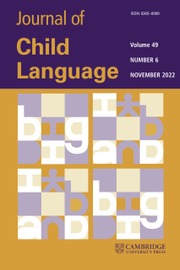Article contents
Vocal production and novel word learning in the first year
Published online by Cambridge University Press: 11 January 2019
Abstract
Previous studies have demonstrated an effect of early vocal production on infants’ speech processing and later vocabulary. This study focuses on the relationship between vocal production and new word learning. Thirty monolingual Italian-learning infants were recorded at about 11 months, to establish the extent of their consonant production. In parallel, the infants were trained on novel word–object pairs, two consisting of early learned consonants (ELC), two consisting of late learned consonants (LLC). Word learning was assessed through Preferential Looking. The results suggest that vocal production supports word learning: Only children with higher, consistent consonant production attended more to the trained ELC images.
- Type
- Brief Research Reports
- Information
- Copyright
- Copyright © Cambridge University Press 2019
References
- 1
- Cited by


